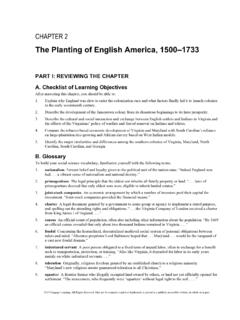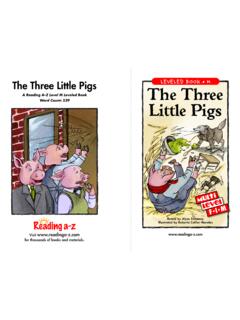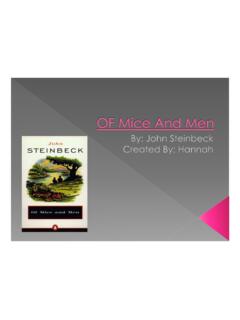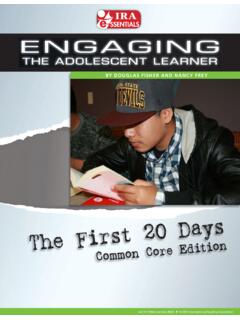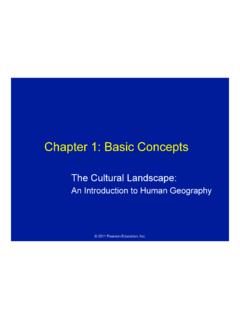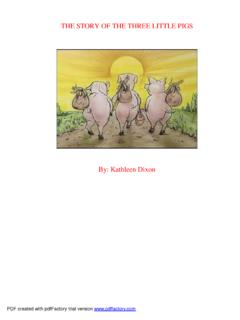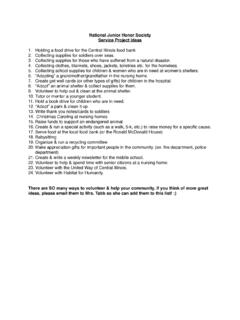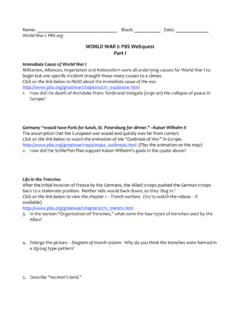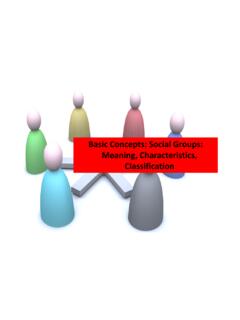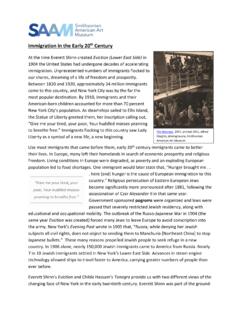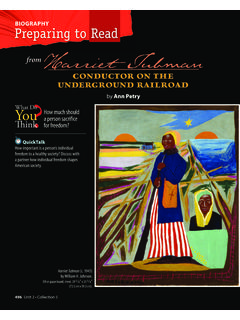Transcription of The Historical Context of Macbeth - Springfield Public Schools
1 The Historical Context of MacbethEXPLORING Shakespeare, 2003 Shakespeare wrote sometime between 1605 and 1606, shortly after the ascension of King James ofMacbethScotland to the English throne. The new monarch brought Scotland previously known to the English only as amysterious, conquered neighbor into the Public limelight. The period of James' reign was further marked bypolitical and religious conflict, much of which focused the kingdom's attention on the danger of in History at the Time of the PlaySourcesFollowing the process used in the creation of many of his plays, Shakespeare drew the plot for fromMacbethhistorical sources particularly Raphael Holinshed's (1577), theChronicles of England, Scotland, and Irelandauthoritative Historical text of the period.
2 Although Holinshed contains the story of Macbeth and Duncan,Shakespeare did not rely on this only; rather, he combined different stories and different versions of the samestory to create his drama. The include an account of King Malcolm II (reigned 1005-34), whose throneChroniclespassed first to Duncan I (reigned 1034-40) and then to Macbeth (reigned 1040-57), both of whom were hisgrandsons. For his portrayal of the murder through which Macbeth took Duncan's throne, Shakespeare minedanother vein of the King Duff's death at the hands of one of his retainers, Donwald. In combining theChroniclestwo events, Shakespeare crafted a specific tone for the tale of King Malcolm II of Scotland died in 1034, his last command was that the throne should pass to his oldestgrandson, Duncan.
3 This last request went against the Celtic tradition of succession, which stipulated that theinheritance of the throne alternate between different branches of the family, and simultaneously cut out anothergrandson, Macbeth , from the line of inheritance. Macbeth nevertheless pursued his claim to the throne asprescribed by tradition. He further supported his claim through the ancestry of his wife, Lady Gruoch, who was adirect descendent of two earlier Scottish kings, Malcolm I and Kenneth III. Nonetheless, Macbeth 's claim wasrejected in favor of Duncan's. Macbeth was not immediately hostile to the new king, but several years intoDuncan's reign he raised an army and openly opposed the monarch. Duncan led his own forces against Macbethand was killed in the ensuing battle.
4 With Duncan out of the way, and his two sons out of the country, Macbethbecame king of Scotland. He held the throne without incident for seventeen years until Duncan's oldest son,Malcolm III, returned to Scotland with an army. Malcolm killed Macbeth when their armies met at the Battle ofLumphanan. With Macbeth 's death, Malcolm faced one final obstacle to the throne: Lulach, the son of LadyGruoch from an earlier marriage. Lulach, who was actually crowned king immediately following Macbeth 's death,claimed the Scottish throne through the ancestry of his mother. Malcolm did not let this development deter him;he had Lulach murdered and took the crown in 's version of Macbeth 's relationship with his king comes from several places in Holinshed. Themurder mostly derives from Holinshed's description of King Duff's death at the hands of Donwald: King Duff, likeDuncan, is murdered by a nobleman he trusts.
5 Donwald, like Shakespeare's Macbeth , acts with the support of anambitious wife. Furthermore, in his account of the later history, Holinshed describes Duncan as an ineffectivemonarch who realized his own weakness enough to enlist the aid of Macbeth and Banquo to fight offMacdonwald's invasion from the Hebrides. Macbeth and Banquo defeated this invasion, as well as a subsequentinvasion by Sweno of Norway. Other elements of that can be traced to Holinshed's includeMacbethChroniclesMacbeth's attempt to murder Banquo and Fleance and Macbeth 's death at the hands of 's ScotlandShakespeare sets his drama at a moment in Scottish history soon after the end of English rule, which haddominated Scotland from the beginning of the tenth century. Although the sources from which Shakespeareworked all referred to events that had taken place in eleventh-century Scotland, the play itself was not a narrowlyhistorical document.
6 Shakespeare adopted and adapted the time and setting for the purposes of his drama,creating an evocation of medieval Scotland whose mood would frame the actions of his fictional , the play refers often to details of Scottish culture at that time, without an understanding of whichthe audience can miss some of the play's Norse invasion raiders and settlersDuring the ninth century Scotland found itself under invasion by raiders from Norway and Denmark, commonlyknown as Vikings or Norsemen, who dominated the northern seas for several hundred years. The villages andmonasteries of Scotland, often isolated in a landscape comprised of offshore island chains, deep inlets or fjords,and rugged mountains, were easy targets for the Norse rovers. The Scandinavian pirates launched raids onScotland from the surrounding islands, and few monasteries or villages could hope to defend themselves fromthese attacks.
7 The Hebrides island chain off the western coast of Scotland, from which Sweno led the attack thatMacbeth repulses at the beginning of the play, often served as bases for the Vikings, who controlled the time, however, some of the invaders settled in Scotland, discovering that the land was fertile for intermarriage and conversion to Christianity in the tenth century, these settlers assimilated completelyinto the Scottish and the supernaturalLike many European cultures of the period, medieval Scotland maintained a belief in witches, including theirability to make prophecies and to affect the outcome of certain events. Shakespeare's depiction of Macbeth 'sencounters with the witches drew on both eleventh-century Scottish belief in witches and Renaissance Englishbelief in witches.
8 For his specific images, the playwright could cull from a variety of sources, includingHolinshed's In general, witchcraft was regarded as an evil practice, involving some kind with the devil, and was therefore considered a threat to social stability. Scottish authorities often tookextreme measures against witchcraft, such as King Kenneth's proclamation that witches who called up spirits forsupernatural aid should be burned to Events at the Time the Play Was WrittenKing James IWhen Queen Elizabeth's rule ended in 1603, she was succeeded to the throne by King James I, the son of Mary,Queen of Scots. He had ruled Scotland as King James IV since 1581. Scholarly discussions of haveMacbethoften assumed a significant correspondence between James I's ascension to the throne in 1603 andShakespeare's composition of sometime soon after; some critics further contend that the play wasMacbethwritten to be played not in the Globe theater, but as a private performance before the king.
9 The story containsmany reflections of James' interests: the family tree of Scottish royalty, the issue of "just" kingship, the threat ofregicide, and witchcraft. Shakespeare addresses his monarch's interest in ancestry by including a scene in whichthe witches conjure an image of King James's ascent to the throne through a family tree traced back to Gowrie ConspiracyOn August 5, 1600, an assassination attempt on King James, then of Scotland, nearly succeeded. The Earl ofGowrie and his eldest brother, Alexander Ruthven, deceived the King into meeting alone with a man supposedlycharged with theft, but actually armed to kill the monarch who was, at that moment, without the protection of hisretinue. The attempt on the king's life captured the Public 's attention a deluge of pamphlets about the affairappeared, including one penned by the king himself.
10 Sermons presented throughout England and Scotlandfocused on the blasphemy of the attempted murder. At this time, while murder itself was considered a crime anda sin, regicide specifically, the murder of a king was an even greater crime and sin. A murderer who assaulteda king took not only a human life, but also, according to popular belief, a ruler whose monarchy was determinedby Gunpowder PlotOn November 5, 1605, another attempt at regicide came to light: the Gunpowder Plot, motivated by the religiousstrife between Protestants and Catholics in general and by James' severe measures against Roman Catholics inparticular. The plotters, a group of Catholics opposed to the Protestant monarchy, formulated a plan to kill KingJames, the royal family, and dozens of government officials.
